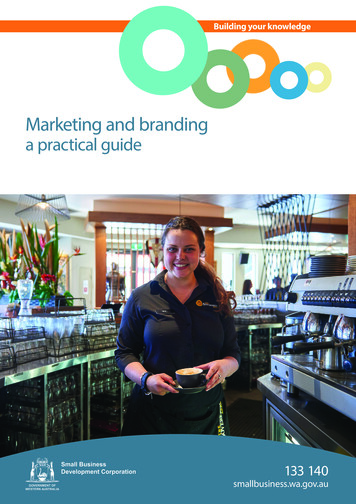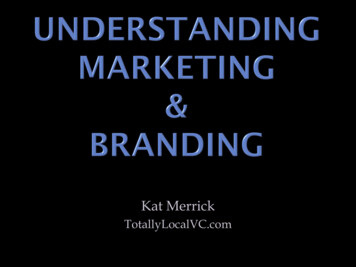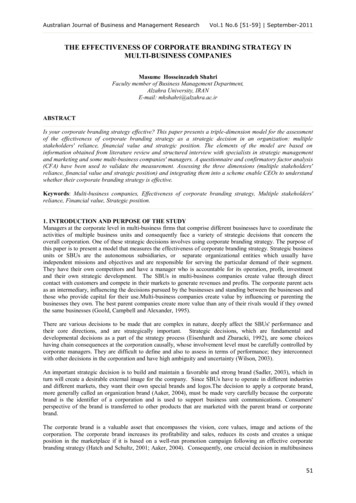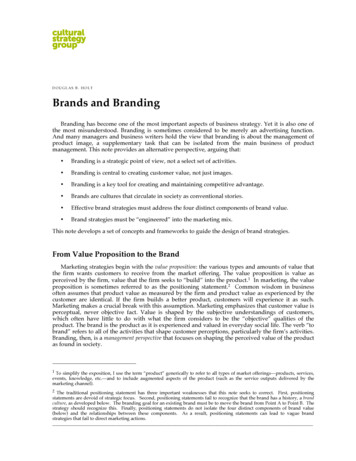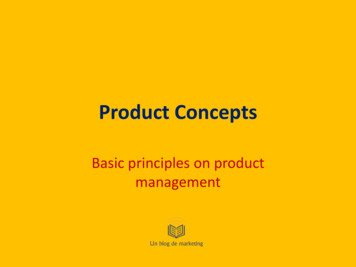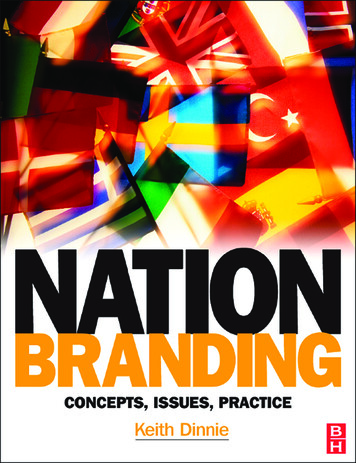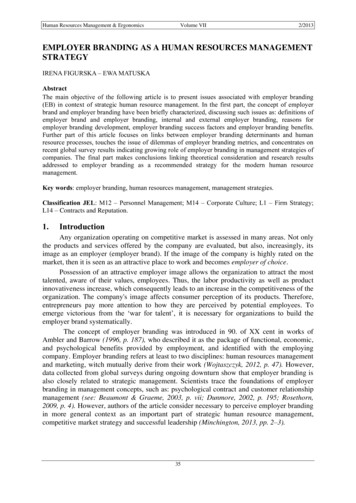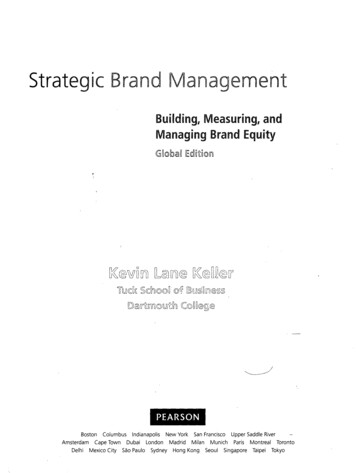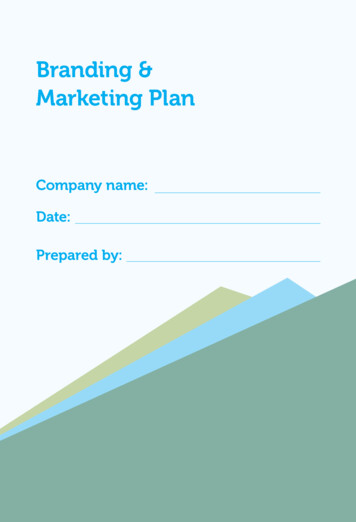
Transcription
Branding &Marketing PlanCompany name:Date:Prepared by:1
InstructionsFill in and tear-off pages at end of each chapter to build your Marketing Plan as you workthrough this guide. Use this page as the cover for your working document.2
Branding and Marketing Plan – SWOT AnalysisSWOT ANALYSISComplete a basic SWOT analysis of your company by identifying a few key points aboutthe internal strengths and weaknesses of your company as well as opportunities andthreats from external forces in the food and beverage industry.STRENGTHS (Internal)WEAKNESSES (Internal)OPPORTUNITIES (External)THREATS (External)3
Branding and Marketing Plan – Business GoalsCompany: Date:Prepared by:Marketing plays a key role in supporting your overall business goals. But you need clearlydefined goals in order to achieve them.Write down the top business goals for your company. Try to keep goals as conciseas possible; be more specific than “make more money” or “sell more product.” ThinkS.M.A.R.T. (specific, measurable, achievable, relevant and timely).Here are some other things to consider when creating your goals: What consumer behaviour are you trying to change? Are you looking for brand share increase (i.e. pick me first)? Is repeat purchase your goal (i.e. make it part of your everyday)? Do you want to offer product trial (i.e. try our new product)? Are you creating a brand extension (i.e. add on to existing product line)? For B2B organizations, is loyalty an objective (i.e. stay with us)?Business goals:1.2.3.4
Branding and Marketing Plan – Your CustomerQ1. Define your customer: Identify your targeted customer(s)(Circle those that apply to your business)B2BB2CD2CNotes:Q2. Describe your customer. (e.g. location, gender, age, education, income level, lifestyle,values, etc.)Q3. What are the top food trends affecting your customer? (e.g. seasonality, convenience,health and wellness, local, functional, etc.)Q4. What are your customer’s media habits? (e.g. newspapers, TV, magazines, radio, TV,direct mail, cell phone, online, etc.)Q5. What product attributes are important to your customers? (e.g. serving size,packaging, ingredients, taste, price, etc.)5
Branding and Marketing Plan – Your CompetitionQ1. Who are your direct and indirect competitors? How large are they in comparison toyour company?Q2. O n the following graph, position your brand in comparison to your main competitors.price quality - /- Position your product Position yourcompetitor’s productQ3. How do your product attributes compare to your leading competitor’s products?(e.g. serving size, packaging, ingredients, taste, price, etc.)6
Branding and Marketing Plan – Your CompetitionQ4. What processes have you established to keep your industry intelligence andcompetitor profiles updated?7
Branding and Marketing Plan – Market PositionMarket positioning is all about finding a comfortable niche that your brand will fit into in themarket – one that will allow it to grow, set apart from the competition. It also guides yourongoing decision-making process with regard to the four Ps of market positioning – product,pricing, placement and promotion.Product: Having a thorough understanding of the products on the shelves – yours andyour competitors – can allow you to use different techniques and methods to present yourproducts to customers.Q1. How do you define your product’s attributes, features and consumer benefits?Pricing: Your product must be priced not only to meet your business goals, but it must alsobe priced in accordance with competitive activity.Q2. Is your brand a premium brand or a value proposition?Q3. What is our pricing strategy?Placement: How you get your product to market is an essential marketing strategy that willimpact every step of your product’s value proposition.Q4. How is your product distributed?Q5. Who manages the relationship with your end consumer?Promotion: The promotion element of marketing gets the most attention, but it should bethe final step in the marketing process.You will complete a current and future tactical mix exercise in an upcoming worksheet.8
Branding and Marketing Plan – Key MessagesELEVATOR SPEECH & KEY MESSAGE EXERCISEAn “elevator speech” is a good way of thinking about your brand in a clear, simple way.Imagine you enter an elevator and realize you’re heading to the 14th floor with one otherperson. The doors close, and that person says, “So, what business are you in?” Can youdescribe what you do in the time it takes for the elevator to reach your destination?Question: “What do you do?”1. Answer (Incorrect): “I own a bakery.” This says nothing about you, and isnot compelling.2. Answer (Correct): “My company produces the market-leading brand of packagedbagels in south-western Ontario.” You have established a key strength – this statementsuggests a huge, consistent customer base, which equates credibility andproduct excellence.3. Answer (Correct): “I own a regional bread-making company that distributes ourproducts across south-western Ontario as a white-label house-brand for major retailers.”This shares your targeted customer base, and your key competencies – clear anddirected communication.4. Answer (Correct): “I manufacture a brand of artisanal flatbreads, new to Ontario, thatfeature locally-sourced Ontario grains – we’re in the process of securing new distributors.”This sentence conveys key attributes about you – not only product strengths, but yourneeds as well. You never know who may be in the position to help you.Write down how you would describe what you do, your “elevator speech”:Your “elevator speech” should be your primary key message, but it is important to take amoment to write five things you want people to know about your company or product, theseare your key messages – and be as concise as possible:1.2.3.4.5.9
Branding and Marketing Plan– Brand Health ChecklistMany people will view your brand assomething different from your product:your brand is the sum total of allimpressions about your company, product,and all other associations. With that inmind, review the following checklist: Do you believe that your brand is unique?Y N Have you defined the messages yourbrand must communicate?Y N Do you own your brand (unique name,trademarks, etc.)?Y N Does your brand link to your company’sbusiness plan, vision and culture?Y N Does your brand communicate a promiseto your customers?Y N Is your brand visually distinguished fromcompetitors?Y N Is your brand identity consistently reflectedin its visual appearance?Y N Does your brand communicate what yourproduct and service provides?Y N Does your company history add value andcredibility to your brand?Y N Have you measured the effectiveness ofyour brand?Y N The more times you answered “yes” toeach of these questions, the healthieryour brand.10
Branding and Marketing Plan– Branding Consistency ChecklistConsider your product’s packaging, andall other visual elements that supportyour business, including all written words,regardless of where they may appear.3. Physical Marketing AssetsAre the following elements consistent inappearance and message, regardless ofwhere they appear? Do they consistentlycontribute to the “sum total” of elementsthat define your brand?Y N b. Product nameY N c. LogoY N d. FontsY N e. Consistent colour schemesY N f. Regularly-used photographsY N 2. Written Wordsa. Basic company informationY N b. Slogan / TaglineY N c. Key brand messagesY N d. Advertising copyY N e. Mission & Vision StatementY N f. Positioning StatementY N Y N b. InvoicesY N c. WebsiteY N d. LetterheadY N e. Business cardsY N f. Vehicle signageY N If you answered “no” to any of these,you have a challenge with your brandconsistency. It’s commonly acknowledgedthat people remember something betterwhen they have seen it repeatedly, andthe most successful campaigns arerepeated until the brand is burned intoyour brain – because they do so withconsistent repetition.1. Visual Elementsa. Company name / Wordmarka. Product packaging11
Branding and Marketing Plan – Tactical MixQ1. What is your current tactical mix? List all the tactics that you currently employ underthe relevant umbrella omotionInternetMarketingAdvertisingQ2. See the Tactical Checklist pull-out on the next page to discover which tools you canadd to your promotional mix, depending on your market channel. Using the umbrella below,identify what tactics that you plan to employ in the otion12InternetMarketingAdvertising
Fill in and tear-off pages at end of each chapter to build your Marketing Plan as you work . through this guide. Use this page as the cover for your working document. 3 Branding and Marketing Plan - SWOT Analysis . SWOT ANALYSIS Complete a basic SWOT analysis of your company by identifying a few key points about .
